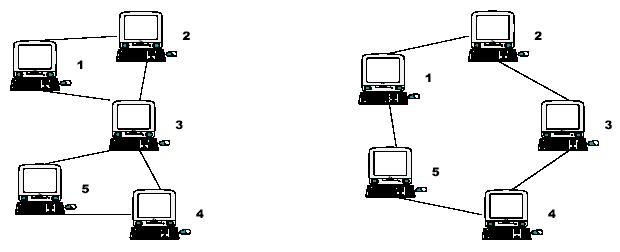【POJ】1523 SPF(割点)
http://poj.org/problem?id=1523
太弱。。。
too weak。。
割点我都还要看书和看题解来写。。果然是写不出么。。
割点就那样求,然后分量直接这个节点有多少子树就有子树个数+1个分量。还要注意root的特判。。sigh。。就是崩这里了。
#include <cstdio>
#include <cstring>
#include <cmath>
#include <string>
#include <iostream>
#include <algorithm>
#include <queue>
using namespace std;
#define rep(i, n) for(int i=0; i<(n); ++i)
#define for1(i,a,n) for(int i=(a);i<=(n);++i)
#define for2(i,a,n) for(int i=(a);i<(n);++i)
#define for3(i,a,n) for(int i=(a);i>=(n);--i)
#define for4(i,a,n) for(int i=(a);i>(n);--i)
#define CC(i,a) memset(i,a,sizeof(i))
#define read(a) a=getint()
#define print(a) printf("%d", a)
#define dbg(x) cout << (#x) << " = " << (x) << endl
#define printarr2(a, b, c) for1(_, 1, b) { for1(__, 1, c) cout << a[_][__]; cout << endl; }
#define printarr1(a, b) for1(_, 1, b) cout << a[_] << '\t'; cout << endl
inline const int getint() { int r=0, k=1; char c=getchar(); for(; c<'0'||c>'9'; c=getchar()) if(c=='-') k=-1; for(; c>='0'&&c<='9'; c=getchar()) r=r*10+c-'0'; return k*r; }
inline const int max(const int &a, const int &b) { return a>b?a:b; }
inline const int min(const int &a, const int &b) { return a<b?a:b; } const int N=2005;
int ihead[N], cnt, rt, iscut[N], FF[N], LL[N], fa[N], tot;
struct ED { int to, next; }e[N*N];
void add(int u, int v) {
e[++cnt].next=ihead[u]; ihead[u]=cnt; e[cnt].to=v;
e[++cnt].next=ihead[v]; ihead[v]=cnt; e[cnt].to=u;
}
void tarjan(int u, int fa) {
FF[u]=LL[u]=++tot;
int child=0;
for(int i=ihead[u]; i; i=e[i].next) {
int v=e[i].to;
if(!FF[v]) {
tarjan(v, u);
++child;
if(LL[v]>=FF[u]) ++iscut[u]; //dbg(iscut[u]); dbg(u);
LL[u]=min(LL[v], LL[u]);
}
else if(FF[v]<FF[u] && fa!=v) LL[u]=min(LL[u], FF[v]);
}
if(child==1 && fa==-1) iscut[u]=0;
else if(child>1 && fa==-1) iscut[u]=child-1; //特判
} int main() {
int u, v, cs=0;
while(1) {
u=getint(); if(u==0) break;
v=getint();
CC(ihead, 0); CC(iscut, 0); cnt=tot=0; CC(FF, 0); CC(LL, 0);
++cs;
add(u, v); rt=max(rt, v);
while(1) {
u=getint(); if(u==0) break;
v=getint();
add(u, v); rt=max(rt, v);
}
for1(i, 1, rt) if(ihead[i] && !FF[i]) tarjan(i, -1);
// for1(i, 1, rt) if(hav[i] && iscut[i]) printf("%d\n", i);
int flag=0;
printf("Network #%d\n", cs);
for1(i, 1, rt) if(iscut[i]) printf(" SPF node %d leaves %d subnets\n", i, iscut[i]+1), flag=1;
if(!flag) puts(" No SPF nodes");
puts("");
}
return 0;
}
Description
Node 3 is therefore a Single Point of Failure (SPF) for this
network. Strictly, an SPF will be defined as any node that, if
unavailable, would prevent at least one pair of available nodes from
being able to communicate on what was previously a fully connected
network. Note that the network on the right has no such node; there is
no SPF in the network. At least two machines must fail before there are
any pairs of available nodes which cannot communicate.

Input
input will contain the description of several networks. A network
description will consist of pairs of integers, one pair per line, that
identify connected nodes. Ordering of the pairs is irrelevant; 1 2 and 2
1 specify the same connection. All node numbers will range from 1 to
1000. A line containing a single zero ends the list of connected nodes.
An empty network description flags the end of the input. Blank lines in
the input file should be ignored.
Output
The first network in the file should be identified as "Network #1",
the second as "Network #2", etc. For each SPF node, output a line,
formatted as shown in the examples below, that identifies the node and
the number of fully connected subnets that remain when that node fails.
If the network has no SPF nodes, simply output the text "No SPF nodes"
instead of a list of SPF nodes.
Sample Input
1 2
5 4
3 1
3 2
3 4
3 5
0 1 2
2 3
3 4
4 5
5 1
0 1 2
2 3
3 4
4 6
6 3
2 5
5 1
0 0
Sample Output
Network #1
SPF node 3 leaves 2 subnets Network #2
No SPF nodes Network #3
SPF node 2 leaves 2 subnets
SPF node 3 leaves 2 subnets
Source
【POJ】1523 SPF(割点)的更多相关文章
- POJ 1523 SPF (割点,连通分量)
题意:给出一个网络(不一定连通),求所有的割点,以及割点可以切分出多少个连通分量. 思路:很多种情况. (1)如果给的图已经不是连通图,直接“ No SPF nodes”. (2)求所有割点应该不难 ...
- POJ 1523 SPF 割点与桥的推断算法-Tarjan
题目链接: POJ1523 题意: 问一个连通的网络中有多少个关节点,这些关节点分别能把网络分成几部分 题解: Tarjan 算法模板题 顺序遍历整个图,能够得到一棵生成树: 树边:可理解为在DFS过 ...
- POJ 1523 SPF 割点 Tarjan
SPF Time Limit: 1000MS Memory Limit: 10000K Total Submissions: 9317 Accepted: 4218 Description C ...
- Electricity POJ - 2117 + SPF POJ - 1523 去除割点后求强连通分量个数问题
Electricity POJ - 2117 题目描述 Blackouts and Dark Nights (also known as ACM++) is a company that provid ...
- poj 1523 SPF(双连通分量割点模板)
题目链接:http://poj.org/problem?id=1523 题意:给出无向图的若干条边,求割点以及各个删掉其中一个割点后将图分为几块. 题目分析:割点用tarjan算法求出来,对于每个割点 ...
- zoj 1119 / poj 1523 SPF (典型例题 求割点 Tarjan 算法)
poj : http://poj.org/problem?id=1523 如果无向图中一个点 u 为割点 则u 或者是具有两个及以上子女的深度优先生成树的根,或者虽然不是一个根,但是它有一个子女 w, ...
- POJ 1523 SPF tarjan求割点
SPF Time Limit: 1000MS Memory Limit ...
- POJ 1523 SPF(求割点)
题目链接 题意 : 找出图中所有的割点,然后输出删掉他们之后还剩多少个连通分量. 思路 : v与u邻接,要么v是u的孩子,要么u是v的祖先,(u,v)构成一条回边. //poj1523 #includ ...
- POJ 1523 SPF (去掉割点能形成联通块的个数)
思路:使用tarjan算法求出割点,在枚举去掉每一个割点所能形成的联通块的个数. 注意:后来我看了下别的代码,发现我的枚举割点的方式是比较蠢的方式,我们完全可以在tarjan过程中把答案求出来,引入一 ...
- POJ 1523 SPF (无向图割点)
<题目链接> 题目大意: 给你一个连通的无向图,问你其中割点的编号,并且输出删除该割点后,原图会被分成几个连通分量. 解题分析: Tarjan求割点模板题. #include <cs ...
随机推荐
- 用sqldevelop进行连接linux中ret Hat 6.2 中的oracle步骤
1.下载Oracle Instant Client (32-bit) 因为PL/SQL只支持32位的Oracle,所以必须下载对应的32位的才可以. 只需要下载instantclient-basic- ...
- Android 打造完美的侧滑菜单/侧滑View控件
概述 Android 打造完美的侧滑菜单/侧滑View控件,完全自定义实现,支持左右两个方向弹出,代码高度简洁流畅,兼容性高,控件实用方便. 详细 代码下载:http://www.demodashi. ...
- 【小程序】微信小程序打开其他小程序(打开同一主体公众号下关联的另一个小程序)
微信小程序打开其他小程序(打开同一公众号下关联的另一个小程序) 注:只有同一(主体)公众号下的关联的小程序之间才可相互跳转 wx.navigateToMiniProgram(OBJECT) wx.n ...
- Python装饰器(Decorator)简介
Python有许多出色的语言特性,装饰器(Decorator)便是其中一朵奇葩.先来看看一段代码: def deco1(f): print 'decorate 1' return f def deco ...
- Nginx+Windows负载均衡(转载)
一.下载Nginxhttp://nginx.org/download/nginx-1.0.8.zip解压到C:\nginx目录下二.在两台服务器上分别建一个网站:S1:192.168.16.35:80 ...
- vue使用axios,进行网络请求
1.首先自己创建一个组件: https://www.cnblogs.com/fps2tao/p/9559291.html 2.安装:axios(可以npm安装,也可以下载js引入文件) npm ins ...
- [CentOS] CentOS for vsftpd with MySQL Virtual user
從ubuntu 12.04的安裝手法拿到CentOS來真的有些很大的不同 絕大部分的語法.概念都是差不多的,只是指令上有些差別,跟ubuntu 有不一樣的地方特別拿出來另外說明 要讓vsftpd與my ...
- java后台分页实例一
后台框架:jfinal + velocity.前台框架:jquery 页面 <!DOCTYPE html> <html> <head> <meta char ...
- Linux iptables常用命令
iptables 是 Linux 中重要的访问控制手段,是俗称的 Linux 防火墙系统的重要组成部分.这里记录了iptables 防火墙规则的一些常用的操作指令. 下面的操作以 CentOS 为基础 ...
- AngularJS 中 Controller 之间的通信
用 Angular 进行开发,基本上都会遇到 Controller 之间通信的问题,本文对此进行一个总结. 在 Angular 中,Controller 之间通信的方式主要有三种: 1)作用域继承.利 ...
